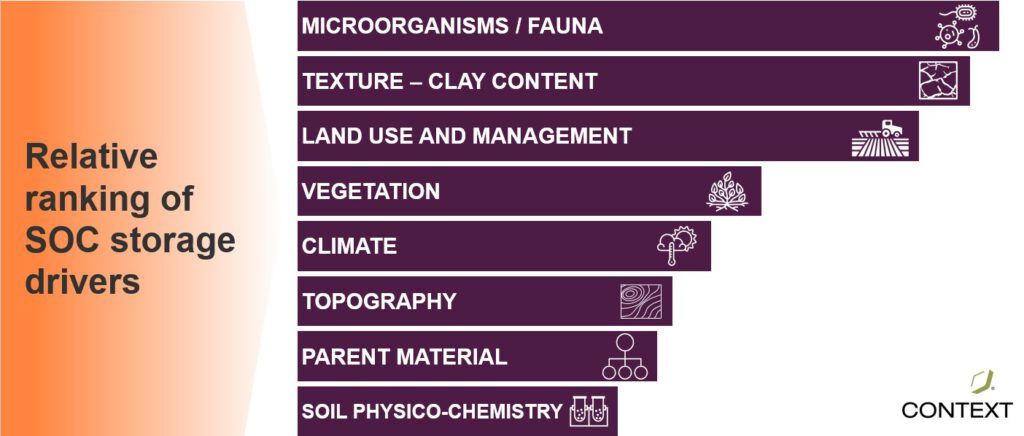What Are the Drivers of Soil Organic Carbon Storage?
Content has been adapted from The Context Network “Get Smart, Stay Smart” Ag Carbon Service.
The short answer: Microorganisms (like bacteria and fungi) and soil fauna (like earthworms) are the biggest driver of soil organic carbon storage (SOC), followed by soil texture.
Back it up: Why microorganisms and soil fauna? Well, storing organic carbon in the soil relies on converting atmospheric carbon—carbon dioxide gas—to plant matter, then into soil organic matter, or SOM.

Figure provided by the Context Network, LLC.
Break it down: SOM includes carbon from a variety of sources, including plant matter, animal tissue or manure, living and dead microbes, and carbon associated with minerals.
The size and diversity of microorganism populations in the soil is the greatest driver of soil organic carbon storage. Without a thriving population of microbes, most added carbon in an agricultural system will return to the atmosphere as carbon dioxide as it decomposes.
Microorganisms and fauna (fungi, bacteria, and invertebrates) decompose the long chains of sugars into shorter carbon chains, converting some sugars back to carbon dioxide in the process. Plus, fungal growth can help bind soil particles together, creating greater soil aggregation.
- Microbes decompose, transform, and stabilize soil organic carbon—they’re the “carbon pump” that turns non-living plant tissue (including crop residue and green manure) into a form of stable carbon that can remain in the soil.
- 80% of stored soil carbon was decomposed and taken up by microbes, one study estimates. That means that most stored soil carbon relies on microbes to decompose it before it can be stored.
- If carbon storage is your goal, then ensuring you have a thriving, diverse population of soil microorganisms is key.
Soil texture and clay content is the second largest driver of carbon sequestration.
- The fine mineral fraction—medium to fine silt and clay particles—often contains most of the soil organic carbon in cropland soils.
- Fine mineral particles have a greater surface area that makes them more reactive, bonding with the smaller organic carbon molecules that microorganisms and fauna have broken down from plant material.
Curious about your soil texture?
- Laboratory analysis of soil texture is expensive, but you can get a quick, rough estimate using the “finger texturing” method—you can find out how here.
Land use and management and vegetation rank third and fourth on the list of SOC storage drivers. These are the factors under a farmer’s control, but they’re not the greatest relative drivers of carbon sequestration.
- It’s important to remember that land use, management, and vegetation type can help sequester organic carbon, but total carbon storage is dependent on a whole suite of other factors.
The remaining factors on the list—climate, topography, parent material, and soil physico-chemistry—play smaller roles as drivers of SOC storage.
Photo courtesy of USDA.








